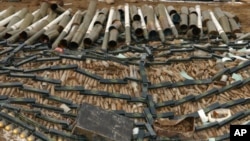In April 2009, a series of explosions rocked the Mbagala District of Tanzania's capital, Dar es Salaam. Aging, unstable munitions improperly stored by the Tanzanian military had spontaneously detonated, killing 26 people and injuring hundreds more. Nor did the damage end there. When the explosions stopped and the resulting fires were put out, as many as 7,000 homes were in ruins.
The threat posed by poorly maintained arms storage sites isn't limited to Tanzania. In 2007, more than 100 people were killed in two separate incidents in Mozambique involving obsolete Soviet-era munitions. That same year, A Congolese Army munitions depot in Equateur Province was destroyed in an explosion, killing three and injuring 52.
Since the 1990s, there have been an increasing number of such catastrophic explosions around the world, as aging weapons left over from Cold War and post-colonial struggles remain stockpiled, but poorly attended. The frequency of such incidents has increased as urban populations in Asia, Africa, South America and even Europe have expanded outward from city centers to the vicinity of what were previously isolated arms depots.
As aging munitions deteriorate further and become more chemically unstable, new tragedies will follow if nations don't adequately acknowledge and address problems with their handling of their military weapons. In many instances, they pose as significant a humanitarian threat as landmines and other remnants of war left uncleared from past conflicts.
Since 2001, the United States has partnered with more than 30 nations to promote the safe disposal of surplus and aging munitions, as well as to improve management of the stockpiles. The U.S. is committed to facing this threat and is actively helping other countries address it.
Aging Munitions, Pervasive Danger

As aging munitions deteriorate further and become more chemically unstable, they pose as significant a humanitarian threat as landmines and other remnants of war left uncleared from past conflicts.


















